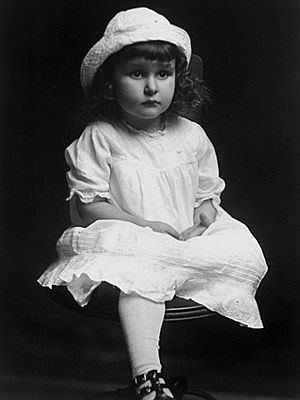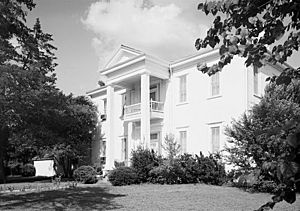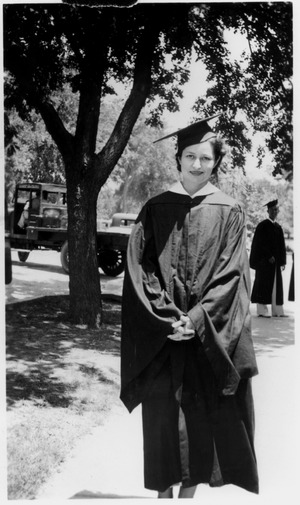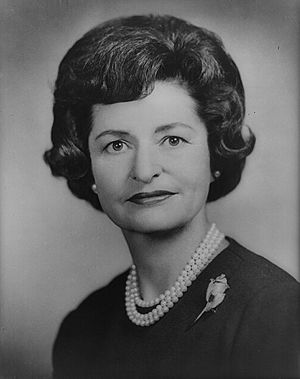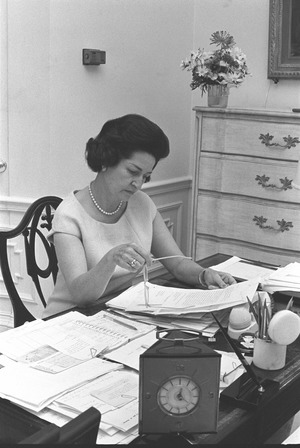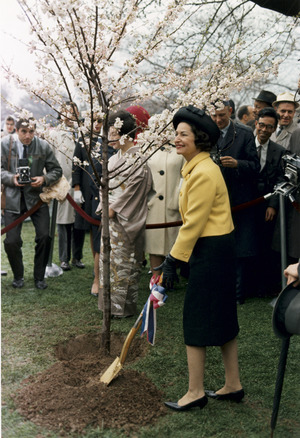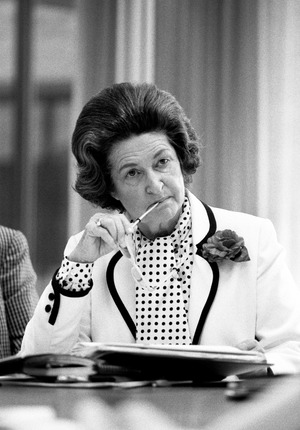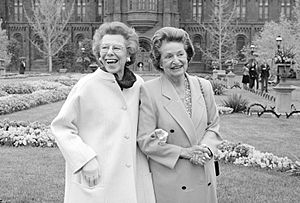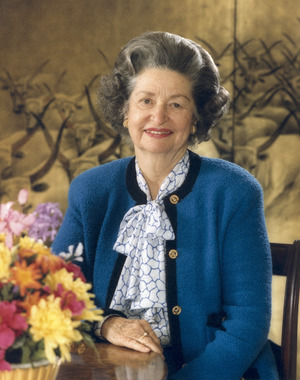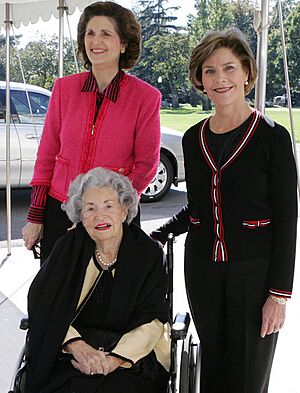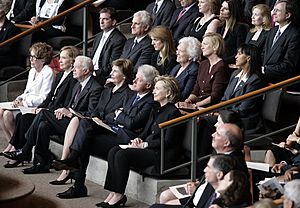Lady Bird Johnson facts for kids
Quick facts for kids
Lady Bird Johnson
|
|
|---|---|
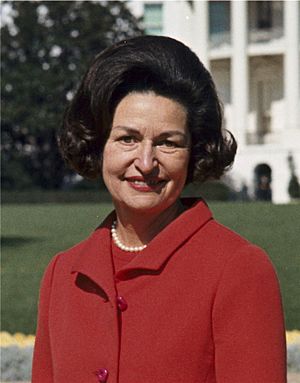
Johnson in 1967
|
|
| First Lady of the United States | |
| In role November 22, 1963 – January 20, 1969 |
|
| President | Lyndon B. Johnson |
| Preceded by | Jacqueline Kennedy |
| Succeeded by | Pat Nixon |
| Second Lady of the United States | |
| In role January 20, 1961 – November 22, 1963 |
|
| Vice President | Lyndon B. Johnson |
| Preceded by | Pat Nixon |
| Succeeded by | Muriel Humphrey |
| Personal details | |
| Born |
Claudia Alta Taylor
December 22, 1912 Karnack, Texas, U.S. |
| Died | July 11, 2007 (aged 94) West Lake Hills, Texas, U.S. |
| Resting place | Johnson Family Cemetery |
| Political party | Democratic |
| Spouse | |
| Children | |
| Education | St. Mary's Episcopal College for Women University of Texas, Austin (BA, BJ) |
| Signature | |
Claudia Alta "Lady Bird" Johnson (born Taylor; December 22, 1912 – July 11, 2007) was the First Lady of the United States from 1963 to 1969. She was married to President Lyndon B. Johnson. Before that, she was the Second Lady from 1961 to 1963 when her husband was vice president.
Lady Bird was very well educated for her time. She was also a skilled manager and a smart investor. After marrying Lyndon Johnson in 1934, she used money she inherited to help fund his political campaigns. She even managed his office when he was away serving in the Navy.
As First Lady, Mrs. Johnson did many new things. She worked directly with Congress and had her own press secretary. She also went on a solo tour to support her husband's election. She strongly believed in making cities and highways more beautiful. Her famous saying was, "Where flowers bloom, so does hope." The Highway Beautification Act was even called "Lady Bird's Bill." She received the Presidential Medal of Freedom in 1977 and the Congressional Gold Medal in 1984. These are the highest honors for a civilian in the U.S. Historians often rank her as one of the most respected American first ladies.
Contents
Growing Up in Texas
Claudia Alta Taylor was born on December 22, 1912, in Karnack, Texas. This town is close to the Louisiana border. Her birthplace was a large old house called "The Brick House." Her father bought it just before she was born.
Her nursemaid, Alice Tittle, gave her the nickname "Lady Bird." She said Claudia was "pretty as a ladybird." People disagree if the name came from a bird or a ladybug. This nickname stuck with her for her whole life. Her family called her Lady, and her husband called her Bird.
Lady Bird's father, Thomas Jefferson Jonson Taylor, was a successful businessman. He owned a lot of land and two stores. Her mother, Minnie Lee Pattillo, died when Lady Bird was only five years old. After her mother's death, Lady Bird was mostly raised by her aunt, Effie Pattillo.
Lady Bird was a shy and quiet girl. She spent a lot of time outdoors by herself. She loved walking, fishing, and swimming. This time in nature helped her develop a lifelong love for the outdoors. She especially loved the wildflowers that bloomed each spring in East Texas.
Her Education Journey
When it was time for high school, Lady Bird had to move away. She lived with another family in Jefferson, Texas, because there was no high school in Karnack. She graduated from Marshall Senior High School at age 15. She was third in her class.
After high school, Lady Bird went to the University of Alabama for a summer. But she missed Texas. She then enrolled at St. Mary's Episcopal College for Women in Dallas. This college helped her decide to become an Episcopalian.
In 1930, she went to the University of Texas at Austin. When her plane landed, she saw a field full of bluebonnets. She immediately fell in love with the city. Lady Bird earned two degrees from the University of Texas. She got a Bachelor of Arts in history in 1933. Then she earned a Bachelor of Journalism in 1934. She was active in student groups and wanted to be a reporter.
Marriage and Family Life
In Austin, a friend introduced Lady Bird to Lyndon Baines Johnson. He was 26 years old and worked for a Congressman. Lady Bird felt very drawn to him. Lyndon proposed to her on their first date! Lady Bird didn't want to rush, but he was very determined. Ten weeks later, she said yes. They got married on November 17, 1934, in San Antonio, Texas.
Lady Bird and Lyndon had two daughters: Lynda Bird (born 1944) and Luci Baines (born 1947). All four of them had the initials LBJ. Their daughters lived in the White House during their teenage years.
Lynda Bird married Charles S. Robb in a White House ceremony. Luci Baines married Pat Nugent. Lady Bird had seven grandchildren and ten great-grandchildren.
Starting in Politics
When Lyndon decided to run for Congress, Lady Bird helped him start his campaign. She used $10,000 from her inheritance to get his political career going. They moved to Washington, D.C., after he was elected. When Lyndon joined the Navy during World War II, Lady Bird managed his congressional office.
Lady Bird often helped calm things down between her husband and others. She was known for being kind and understanding. For example, after Lyndon had a disagreement with a reporter, Lady Bird followed the reporter in her car. She invited him back, explaining that "That's just the way Lyndon sometimes is."
Her Business Success
In 1943, Lady Bird Johnson bought a radio station in Austin called KTBC. She used $17,500 of her inheritance for this. She became the president of the LBJ Holding Co. Her husband helped her get an agreement with the CBS radio network.
Lady Bird decided to buy a television station in 1952, even though Lyndon wasn't sure about it. She reminded him that she could do what she wanted with her own money. This TV station, KTBC-TV/7, was the only one in Austin at the time. It made the Johnsons very wealthy.
Lady Bird's first investment of $41,000 eventually grew into more than $150 million for her company. She was the first wife of a president to become a millionaire on her own before her husband was elected president. She stayed involved with her company until she was in her eighties.
Second Lady of the United States
John F. Kennedy chose Lyndon Johnson to be his running mate in the 1960 election. Lady Bird took a bigger role in the campaign because Kennedy's wife, Jacqueline, was pregnant. Lady Bird traveled thousands of miles and attended many events. Kennedy and Johnson won the election.
Lady Bird later said that being Second Lady was "a very different period of our lives." She often filled in for Jacqueline Kennedy at official events. This experience helped her prepare for her unexpected role as First Lady.
On November 22, 1963, the Johnsons were with the Kennedys in Dallas. President Kennedy was assassinated. Lyndon was sworn in as president on Air Force One just two hours later. Lady Bird and Jacqueline Kennedy were by his side. Lady Bird later recorded her memories of that day to help her cope with the shock.
First Lady of the United States
As First Lady, Lady Bird started a big project to make Washington, D.C. more beautiful. She called it the Society for a More Beautiful National Capital. Her goal was to plant millions of flowers, especially along roads. She famously said, "Where flowers bloom, so does hope."
She worked hard to protect wildflowers and encouraged planting them along highways. Her efforts inspired similar programs across the country. She was the first president's wife to actively support a law. She helped pass the Highway Beautification Act, which was called "Lady Bird's Bill." This law aimed to make highways prettier by limiting billboards and planting flowers. She also supported the Head Start program. This program helps young children from low-income families get ready for school.
Lady Bird changed the role of the First Lady. She was the first to have her own press secretary and chief of staff. Her press secretary, Liz Carpenter, was the first professional newswoman to hold that job for a First Lady. Lady Bird's time as First Lady started the trend of hiring staff to work on the First Lady's projects.
During the 1964 election campaign, Lady Bird traveled through eight Southern states on a special train called the Lady Bird Special. She gave many speeches. This was the first time a First Lady had done a solo whistle-stop tour.
In 1965, Lady Bird dedicated a plaza in Peoria, Illinois. In 1966, she dedicated the Glen Canyon Dam in Arizona. She said the dam belonged to all Americans.
In 1968, at a White House event, the singer Eartha Kitt was asked about her views on the Vietnam War. Kitt spoke out against the war. This reportedly upset President and Mrs. Johnson.
Lady Bird published A White House Diary in 1970. It was her personal account of her husband's presidency. It covered important events like the Great Society programs, the civil rights movement, her environmental work, and the Vietnam War.
Many people considered Lady Bird Johnson to be one of the most effective First Ladies. She was praised for her work on conservation and making public spaces beautiful.
Life After the White House
Former President Johnson died in 1973, four years after leaving office. Lady Bird arranged for his body to be honored at the Lyndon B. Johnson Presidential Library and Museum. She then had him buried in the Johnson family cemetery.
After her husband's death, Lady Bird traveled and spent more time with her daughters. She continued to be a public figure, honoring her husband and other presidents.
In the 1970s, Lady Bird focused on improving the Austin riverfront area. She was involved in the Town Lake Beautification Project. She also served on the board of regents for the University of Texas System. She was the first woman on the National Geographic Society's Board of Trustees.
In 1982, Lady Bird and actress Helen Hayes started the National Wildflower Research Center. This group works to protect and reintroduce native plants. In 1995, it was renamed the Lady Bird Johnson Wildflower Center because of her efforts. It became part of the University of Texas at Austin in 2006.
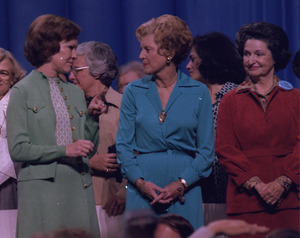
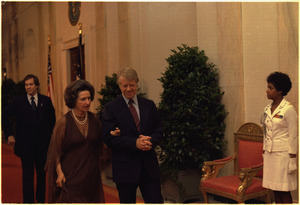
In 1988, Lady Bird met with three other former first ladies: Betty Ford, Rosalynn Carter, and Pat Nixon. They discussed how the U.S. Constitution affected women.
Lady Bird spent her summers on Martha's Vineyard in Massachusetts for 20 years. She loved the island's natural beauty and flowers.
She returned to the White House in 1990 for the 25th anniversary of her husband's inauguration. President George H. W. Bush praised her work.
Later Health and Passing
Lady Bird Johnson's health began to decline in 1986. She had a stroke in 1993, which affected her eyesight. In 2002, she had another stroke, which made it hard for her to speak or walk without help.
Lady Bird Johnson passed away at home on July 11, 2007, at the age of 94. Her funeral was a public event. Her daughter, Luci Baines Johnson, gave a eulogy. Lady Bird was buried next to her husband in the Johnson family cemetery in Stonewall, Texas.
Her Legacy and Honors
Historians have consistently ranked Lady Bird Johnson as one of the most highly regarded American first ladies. She is often praised for her intelligence, accomplishments, and leadership. She is also seen as someone who had a great impact on the country.
On August 27, 1969, President Richard Nixon dedicated a large area of redwood trees as the "Lady Bird Johnson Grove." This was to honor her work in preserving nature. The grove is in Redwood National Park.
Lady Bird Johnson received the Presidential Medal of Freedom in 1977. She also received the Congressional Gold Medal in 1988. She was the first wife of a President to get this honor.
In 1995, the National Wildflower Research Center was renamed the Lady Bird Johnson Wildflower Center. This honored her dedication to native plants.
Columbia Island in Washington, D.C., was renamed Lady Bird Johnson Park in 1968. This was because of her efforts to beautify the capital. After her death, Austin's Town Lake was renamed Lady Bird Lake in her honor. She had led a campaign to clean up the lake.
In 2008, the "Lady Bird Johnson Memorial Cherry Blossom Grove" was dedicated in Marshfield, Missouri. A high school in San Antonio, Texas, was also named Lady Bird Johnson High School in her honor.
In 2012, the United States Postal Service issued a special stamp sheet honoring Lady Bird Johnson. This was a tribute to her work in beautifying the nation's roadsides and parks. In 2013, she was given the Rachel Carson Award for her conservation efforts.
Lady Bird received honorary degrees from many universities. She was also the honorary chairwoman of the Head Start program.
Images for kids
See also
 In Spanish: Lady Bird Johnson para niños
In Spanish: Lady Bird Johnson para niños


